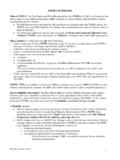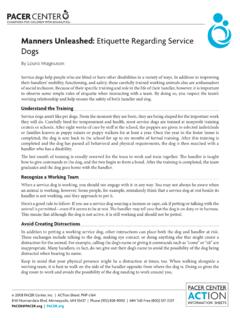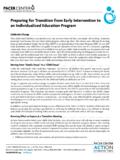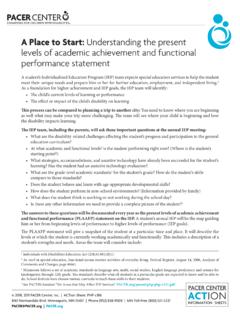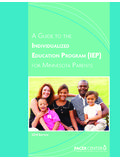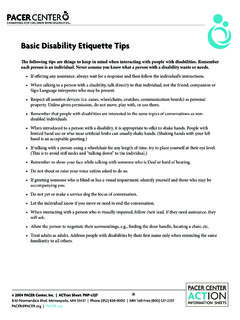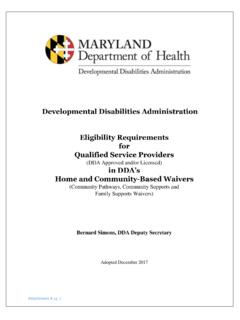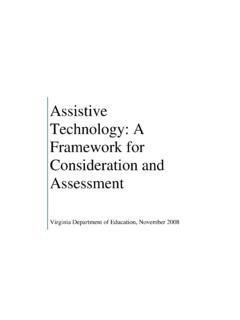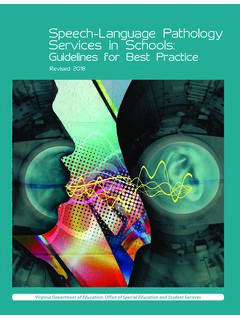Transcription of Examples of Assistive Technology for Young Children
1 8161 Normandale Blvd. | Minneapolis, MN 55437(952) 838-9000 | Fax: (952) 838-0199 | Toll free in MN: (800) | 2015 PACER Center, Inc. | STC-29 Examples of Assistive Technology for Young Children As parents or professionals, one of the greatest tasks is to help Young Children develop their own sense of independence and an understanding of the world around them. What many parents or professionals may not know is there are a large number of available tools collectively known as Assistive Technology (AT) that can help Young Children with disabilities build skills they may be struggling to learn or master.
2 Assistive Technology ranges in complexity from simple, low-tech solutions, such as a crayon with a large foam grip, to sophisticated high-tech tools, such as a computerized device that can speak the thoughts of someone who struggles to communicate verbally. Assistive Technology can help with almost any skill and can be used by Children of any age even infants. Below are Examples of Assistive Technology that can help with common skills Young Children learn. Consider the few items listed here as a starting point to explore the countless opportunities AT can offer Young Children with disabilities .
3 Daily Routines and Activities Assistive Technology provides many different ways to improve a child s independence by making daily routines and activities easier. Common Examples include: Attaching larger grips to zippers and buttons, making it easier to get dressed Displaying simple picture instructions for daily routines (such as washing hands) at home ( , above the sink in the bathroom) Using bowls with suction cups to provide increased stability for Young Children Social Skills and Behavior Assistive Technology can be a valuable tool for redirecting behavior when a child is unhappy, and for teaching important social skills.
4 Common Examples include: Reviewing video models of other Children successfully waiting their turn or listening in order to teach a desired behavior A visual choice board of different calming activities a child can use when they are feeling upset Using a child-friendly timer to alleviate anxiety and create smoother transitions between activitiesSensory Sensory tools can help increase or decrease stimulation to help a child feel more comfortable and secure in their environment. Common Examples include: Noise-blocking headphones to mute sounds in noisy or over-stimulating environments Fidgets, small items that a child can hold, provide extra stimulation needed to help Children focus Weighted blankets or toys that provide slight pressure on the body and help some Children feel more calm and focused Fine Motor SkillsPlaying with and using everyday toys and objects is an important skill for Young Children .
5 Assistive Technology creates ways to adapt objects so that Young Children who struggle with gripping, holding, and manipulating objects 2can use them. Examples include: Adding large foam grips to tools, such as markers, tableware, or toothbrushes, to make them easier to grip and use Attaching grips, such as shower curtain rings, to toys or bottles so that the items can be more easily grasped and used Cutting one finger off of a glove to help a child use a touch screen device that requires isolating a single finger CommunicationBetween birth and age 5, a child s vocabulary (both words they understand and words they can use) grows at a rapid rate.
6 For Children who struggle to communicate verbally, there are many different types of Technology that can provide them with their own voice. Common Examples include: Apps for tablets, such as an iPad, that speak words a child selects on the screen A laminated collection of words and corresponding symbols a child can point to and indicate their feelings, wants, and needs A single message device, consisting of a simple button with a built-in speaker. It records a message ( , I m hungry ) and a child can press the button to activate the message for a parent or caregiverLiteracy Skills From a very Young age, Children can begin to develop literacy skills the concept that text is read from left to right, for example, or that writing can be used to create a message for others to read.
7 Assistive Technology can help make understanding and practicing these skills easier and more engaging for Children with disabilities . Some common Examples include: Adding tabs, commonly called page fluffers, to books. This creates more space between pages and makes turning the pages easier for Children with fine motor challenges. Using electronic software or apps to make books more interactive and usable for Children who struggle to use or focus on standard print books Scribbling and writing with high-contrast colored paper and pens so that writing is easier to see for a child with visual impairmentsComputer Access For Children who struggle to use a computer or mobile device, there are many different ways to adapt the controls so they are more usable.
8 For example: A roller ball mouse with an oversized trackball, which moves the cursor for a child who struggles to grip and use a standard mouse Using simple buttons known as switches that a child can select by using their hand, head, or other method, to perform a computer command such as a click, or by typing on a switch accessible keyboard Zoom features, which magnify the screen of a computer or mobile device to make it easier to use for Children with low visionHow Do I Start Using AT to Help My Child? Every child is unique, and the Assistive Technology each child uses needs to fit their individual situation.
9 with so many options available, exploring Assistive Technology can sometimes feel overwhelming. Consider seeking advice from someone who has experience using Assistive Technology with Young Children . A simple discussion with a knowledgeable professional can provide you with the general information needed to start exploring AT for your child. If your child is under age 3 and has an Individual Family Service Plan (IFSP), talk with your service coordinator about Assistive Technology for your child.
10 If your child is 3 or older and has an Individualized Education Program (IEP), talk to your case manager about Assistive Technology for your child. Your IFSP/IEP team can suggest how AT might help, and discuss Examples of potential Technology to try. For more information on how to get started exploring AT for your child, read the TIKES tip sheet, Explore Assistive Technology and Open New Doors for Your Child at Assistive Technology can make a tremendous difference in the life of your child, and it s up to you to begin exploring the possibilities.
